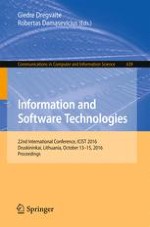2016 | Buch
Information and Software Technologies
22nd International Conference, ICIST 2016, Druskininkai, Lithuania, October 13-15, 2016, Proceedings
herausgegeben von: Giedre Dregvaite, Robertas Damasevicius
Verlag: Springer International Publishing
Buchreihe : Communications in Computer and Information Science
